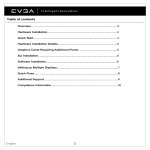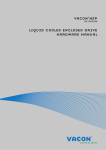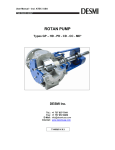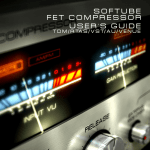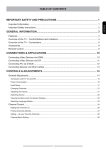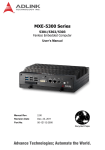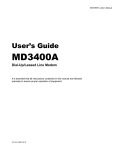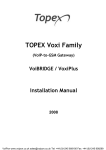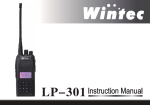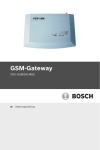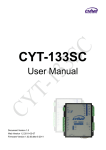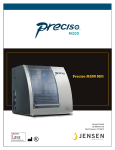Download TOPEX EoneS
Transcript
TOPEX EoneS (E1, VoIP Digital Switch and Signaling Converter) Installation Manual 2008 TOPEX EoneS TOPEX GROUP TOPEX is a group of Romanian companies, founded in 1990, by ten enthusiastic engineers experienced in telecommunications. Its activity is directed to the research, development and production of telecom equipment as well as service. Very quickly, TOPEX become the most important manufacturer of communications solutions for small to large companies as well as for telecommunications operators and providers in Romania. Our company designs equipment for all existing mobile systems (GSM, CDMA), including 3G technology. TOPEX is represented all over Romania by a wide network of local distributors through which the promotion, administration and product maintenance are running. Due to our innovation power, authentic flexibility, real respect for our partners and the secure solutions that we provide TOPEX extended its business worldwide. Currently TOPEX delivers its products through its distributors to: Spain, France, Russia, UK, Nigeria, Greece, Netherlands, Republic of Moldova, Bulgaria, etc. In order to achieve effective and flawless manufacturing for its products, TOPEX has carefully organized its Research and Development Department along with its production facility. This allows TOPEX to have maximum control of all the processes involved in the complex operations related to high-technology electronic manufacturing. Currently, 25 percent of TOPEX personnel are part of R&D Department and their number is increasing. TOPEX also considered the training and the service as an integral part of the solutions it provides. Therefore, comprehensive training sessions are held at the TOPEX factory, complimentary for the company’s clients. Service is also provided via Internet, as all TOPEX solutions are designed especially to allow this, at the lowest cost. TOPEX has implemented the quality management system according ISO9001 standard certified by SRAC since 1997, respectively by IQNET since 2002. In 2001 TOPEX become a sector member of I.T.U. (International Telecommunication Union). The main lines of products of our company are: GSM interfaces (analog, ISDN BRI and PRI, GSM VoIP gateway) CDMA interfaces (voice/data, LAN, EV-DO gateway, GPS, miniature) VoIP gateways (basic, GSM/CDMA/UMTS, advanced) Custom systems for special applications (air traffic control, railway dispatching center) Phone exchanges (analog, digital, private/rural, IP PBX, protocol converters) For more details please visit our website at http://www.TOPEX.ro TOPEX Page 2 TOPEX EoneS Dear client, Thank you for buying the TOPEX EONES multiprotocol digital switch and congratulation for your wise choice. By selecting EONES you have chosen: 9 9 9 9 9 up to 22 E1 trunks supported scalable and reconfigurable architecture several point codes and several integrated STPs per equipment high-performance services, using advanced digital technology. advanced diagnosis program that monitors the operation of the system in detail; remote operation possible. 9 9 Linksets distributed among the boards of the equipment Integrated and compact solution, up to 660 voice channels in a one 19-inch rack-mountable cabinet 7U high. It uses a single supply powered from the 230V AC Mains. 9 OAM application that offers integrated Graphical User Interface (GUI) and remote management to monitor all voice channels. The user can view and monitor the status of all the cards inserted. The monitoring can be performed locally or remotely over TCP/IP 9 Network conectivity ensured between equipment (switches, gateways, network components) that use incompatible signaling protocols 9 9 Detailed call billing and recording for all of the supported protocols Accurate answer-supervision and line-disconnect supervision based upon the selected signaling protocol (R2, R1, ISDN, SS7 etc). 9 Improved equipment reliability. The main processor and power supply cards are doubled, both for redundancy and for speed increase 9 Increased integration results in higher product reliability and also in less downtime owing to the lower failure rate. 9 Low overall cost. WEEE Directive Compliance This symbol applied on your product or on its packaging means that this product fulfils the WEEE Directive. The product shall not be recycled as household waste; it will be disposed separately as sorted waste. Regarding to WEEE Directive the recycling EE equipments must be accomplish separately in purpose of natural resources preserving and to avoid the occurring negative effects about human health and environment. The acquired product shall not be treated like household waste at the end of its life and will be returned to TOPEX Company at the address: ROMANIA, Bucharest, Feleacu Street no 10, code 014186 or given to a specialized firm. WEEE Directive ! Please do not dispose your TOPEX product as unsorted waste (household waste), recycle it to protect the environment. Separate the packages according to waste disposal options and sort it for recycling. For supplementary information contact us to: Phone: +4021 408.39.00 or www.topex.ro TOPEX Page 3 TOPEX EoneS Table of Content 1 2 3 4 5 6 TOPEX EONES description Hardware Structure 2.1 Cabinet rack description 2.2 System cards 2.2.1 Power Supply Card 2.2.2 Dual E1 trunk card 2.2.3 Main processor card 2.2.4 CCC Card 2.2.5 VoIP card 2.3 Description of connectors from front side of PG 2.3.1 COM1 – serial port for connecting OAM program 2.3.2 COM2- serial port for system Linux console 2.3.3 ETH - Ethernet 10BT for LAN or IP connection INSTALLING TOPEX EONES EQUIPMENT 3.1 Package Content 3.2 Positioning the rack 3.3 Connecting the TOPEX EONES equipment 3.3.1 Connecting E1 cable 3.3.2 Connecting the serial cable for accessing LINUX system console 3.3.3 Connecting the Ethernet cables 3.4 Configuring the TOPEX EONES equipment 3.4.1 Accessing LINUX system console, verifying and modifying IP address of the EONES 3.5 Installing O.A.M. software on a PC TECHNICAL SPECIFICATIONS: OPERATING CONDITIONS 5.1 EONES Environment and Installation Conditions STORAGE, TRANSPORT and CONSERVATION of the EQUIPMENT APPLICATIONS 6.1 Connection to a VoIP Gateway 6.2 Connection to a digital PBX 6.3 Connection to a Carrier Network for Dial Up This manual is revision B, march 2008. TOPEX Page 4 5 5 6 7 7 8 9 10 11 12 12 12 12 13 13 14 14 14 15 15 15 15 20 21 22 22 22 23 23 24 25 TOPEX EoneS 1 TOPEX EONES description TOPEX EONES is a multiprotocol digital switch that accepts up to 11 (eleven) digital cards with dual E1 trunks or VoIP channels. Its modular architecture allows configuration into a diverse range, depending upon the requirements of the clients. The proprietary 19” cabinet rack (7U high and 30 cm deep) accepts different types of multichannel digital plug-in cards: • Dual E1 trunks • VoIP etc. You may use EONES either as a medium capacity (up to 660 calls) digital phone exchange or as an interface between several E1 trunks from different networks to achieve conversion of signaling protocols. For instance, EONES may connect several E1 trunks with SS7 or ISDN singaling to VOIP networks. Or it can interface between R2 signaling and ISDN signaling. TOPEX EONES is a highly flexible switching solution. EONES allows you to insert from one to eleven digital interface cards. When used as a digital PBX, EONES may handle up to 22 E1 trunks, managing the switching tasks for the private company, using all-digital methods for switching. When used as a Trunk Signaling Converter, EONES provides connectivity between incompatible switches or telecomm networks. It enables network connectivity between various switches and equipment that use different signaling protocols. EONES supports multiple signaling protocols, including but not limited to SS7, SIP, H323, QSIG, R1, R2, DTMF. It can be easily upgraded to handle custom or non-standard protocols. The modular design of EONES allows for capacity expansion up to 22 E1 trunks. The OAM program features a user-friendly configuration menu that makes set-up easy. The EONES equipment is a versatile, compact, reconfigurable and high-reliability system that includes all components in a 19-inch rack only 7U high. It fully supports remote supervision and configuration via IP networks. The equipment allows for complete monitoring and comfortable configuration during full operation. Configuration changes can be made without resetting the system. The EONES equipment is equipped with OAM program for detailed diagnostics and to monitor in detail the operation of the system. 2 Hardware Structure TOPEX 19" cabinet rack with 230V~ 48V power supply One or two power supply cards One or two Main processor (PG) cards One or two central switching cards (CCC) Up to 11 digital plug-in cards that may be: o Cards with two E1 trunks and various signaling protocols o VoIP cards with up to 60 voice channels, etc. Page 5 TOPEX EoneS 2.1 Cabinet rack description Figure 1. : Front view of the equipment rack The EONES system is integrated in a 19’’ rack. The height of the equipment is 7U and the depth is 30 cm. Dimensions are 500 x 300 x 265 mm. The cabinet rack is made of aluminum, with black finish. The front panel of the rack is open, equipped with guides for sliding the plug-in cards. You can easily replace, add or remove a card during operation. When not all interface cards are plugged in, the free sections of the front panel must be covered with a lid (cover panels). The bottom and upper sides of the cabinet are covered with perforated sheet. The proprietary backplane (system bus) of the equipment is designed as a printed circuit card (PCB) with two rows of connectors and fitted to the inner rack carrier profiles. Basic Dimensions Overall dimensions (except protrusions) are: 590 mm x 300 mm x 265 mm Front Side On the front, the TOPEX rack is has 19 slots for plug-in cards. The first slots from the right are dedicated, for mandatory cards. The power supply cards, the central switching cards, and main processor cards must be included in any case. The PG and the supply may be single or dual (for load sharing and redundancy). Note that the PG and power supply cards are double-width, so they take two slots each. The remaining 11 slots may be fitted with different digital interface cards (E1, VoIP). Back Side The backside of the TOPEX rack includes the connectors and the AC mains supply unit. On the back panel you can find the receptacle for the power cord to the mains outlet on the wall, toghether with the fuse and the main power switch. The power supply is a switching mode industrial unit with input voltage of 240VAC. Note: TOPEX EONES equipment must be supplied from a voltage within 210 …. 264VAC range. The admissible maximum voltage for equipment functioning is 264VCA. The internal ventilators, located on the back side of the unit, provide adequate cooling. The backside power supply delivers all voltages needed by the equipment, including for the power supply card. The mains power switch (On/Off) and the fuse are also located on the back. TOPEX Page 6 TOPEX EoneS 2.2 System cards EONES may work with one or two power supply cards. In the doubled version, the critical components (PG and power cards) are doubled, if one fails, the equipment can continue operation with a single card. 2.2.1 Power Supply Card This card is a double-width one, 40mm wide. It includes a regulated power supply and optionally a ring voltage generator and ensures the supply of the EONES cabinet rack with +5V and –5V voltages. It draws its power from the regulated 48VD.C. voltage of the rack power supply. The power supply card must deliver these three voltages: • +5 VDC ±2% with maximum output current of 8 A • -5 VDC ±5% with maximum output current of 2,5 A • 80 Vrms @ 25 Hz ring signal, max. power 15W To ensure a higher reliability, EONES may work with two power supply cards. One card is active, while the other acts as back-up. If the first card fails, the second goes online automatically, ensuring continuous operation of the EONES equipment. Significance of indicators and controls - 48V Lights up to show presence of input voltage (-48VD.C ). This LED should be ON while the power supply card is operating. Test points Factory use only. A bank (2x4) of small round holes for inserting testing terminals to measure the optput voltages. ON/OFF Switch Local power switch, must be ON for the card to operate. Always turn the switch OFF before pulling out the power card! SET Factory use only.Two round holes for inserting the tip of the screwdriver. Used to adjust (fine tuning) the values of the two DC output voltages. - 5V Lights up green when -5V voltage is on + 5V Lights up green when +5V voltage is on RING It holds significance only for the equipment version fitted with ringer generator. If the equipment has ringer generator this LED will blink green. ACTIV Lights up green to show the respective power card is active. FAIL Lights up red to show a supply problem (failure). In normal operation this LED must be off. Warning: The power supply card has a local ON/OFF switch (the ON position is the upper one) Be sure to turn the switch ON only after the card has been properly inserted into the equipment. Always ensure that the power switch is OFF (down) before pulling out the power card! TOPEX Page 7 TOPEX EoneS 2.2.2 Dual E1 trunk card The E1 trunk card is a single width card, 20mm wide. It features two E1 interfaces (RJ45 female connectors) that conform to G. 703 and have a frame structure according to ITU-T (CCITT) standard G. 704. It’s internal clock generator can operate independently or synchronized to ane external criteria, allowing the operation of several cards in the same equipment. Supported signaling includes R2 generic CAS (Channel Associated Signaling in accordance both with ITU-T Q.421/Q.422 and with Q.411/Q.412), ISDN DSS1, and SS7. The encoding follows the A Law and the bit rate is the standard 2,048 Kbps. Nominal impedance is 100 ohm standard, but it can be set to 75 ohm. EONES can take up to 11 (eleven) E1 cards, totalling 22 E1 digital trunks. Significance of indicators and controls: Each E1 connector features a green and an orange LED, to show physical connection and data traffic on the respective trunk interface. HB Heartbeat LED, green color. It pulses steadily when everything is OK, its frequency depending of type of the signalization protocol used LOS Lights up red to show “Loss of Incoming Signal” error. R Reset button, that is recessed (so can’t be pressed accidentally) LR Reset LED, lights up red during card initialization (reset) or on error TOPEX Page 8 TOPEX EoneS 2.2.3 Main processor card The Main processor (PG) card is also a double-width (40mm) card. It contains a powerful processor controlling the whole system. EONES may use one or two PG cards, working in load sharing mode and ensuring a certain level of redundancy. The PG card includes multiple printed circuit cards featuring space-time switches and DSP circuits. It also has a harddisk for the operating system, application programs and data storage. PG features on the front panel one Ethernet connector (10Base-T) and two serial interfaces (DB9) labelled COM1, COM2. These interfaces are used to connect the TOPEX EONES system to a computer or to the Internet, for installation and servicing or for permanent operation. Through these ports you may perform the configuration, administration and maintenance operation for the EONES equipment. Significance of indicators and controls RESET Hidden (recessed) button for reset HB Heartbeat LED, blinks green steadily during normal operation GCK Clock generation LED. Lights green to indicate that the local clock generator on the PG card is active. Normally it is inactive, the clock signal is received from the E1 card. In any system, only one clock genrator may be active at a moment of time. ALRM Alarm LED, lights up red to show an error ! The processor card must be inserted, in rack, only on the first double slots (from left to right view). If the rack is equipped with a single processor card and one power supply card, these must be inserted on dedicated slots (1 and 2 double slots for Processor card and 3, 4 for power supply card), the free slots are covered with blanks. TOPEX Page 9 TOPEX EoneS 2.2.4 CCC Card CCC is the Central Switching card, the main switching matix of the equipemnt. It is aa single width card, 20mm wide. EONES must always use two such cards. The switching field consists of four 8 by 8 matrices. It acts as square non-blockig matix 16x16. The CCC card features an internal serial interface (not on the front panel ) used only for debugging. There are no external connectors on this card. The two square switching planes of the EONES equipment are NOT interconnected. Each E1 or VoIP card is connected wia one E1 trunk to the first CCC card and via a second E1 trunk to the other CCC card. Likewise, the CCC cards are each connected via one E1 trunk to the first PG card, and via aonther E1 trunk to the second Main processor card. Thus the maximum capacity of the EONES system is of 2x14 digital cards (E1 or VoIP) but currently only 22 are supported, because of mechanical limitations (lenght of the system bus) Significance of indicators and controls HB – Heartbeat (Activity) Green LED, should blink steadily to indicate normal operation of the CCC card. GCK – Clock Generator Active Lights up to indicate generation of clock signal on this board. In any system, only one of the cards can act as a clock generator. ALARM – Alarm indicator Red LED, lights up to show an error. L. RESET – Reset indicator Red LED, lights up briefly to show that a reset has occurred. RESET- The reset button of the CCC card. TOPEX Page 10 TOPEX EoneS 2.2.5 VoIP card The VoIP card (Voice over IP) is used to transmit voice packets through the Internet. It is a single width card, 20mm wide. XVoIP can manage different numbers (60/30/18/8) of simultaneous calls. The card features on the front panel a serial interface (labelled COM) and four Ethernet connectors (type 10/100 BASE-T). The serial interface is used to debug the processor card. The Ethernet connectors perform the followings functions: • Upper ETH, labeled “WAN” is used to connect the TOPEX VoIP card to the IP network (Internet). The name WAN suggests it is intended for connection to the outside world! • Middle connectors LAN2 and LAN1 can connect other devices to the TOPEX equipment (Laptop, notebook, PC, etc.). They are part of a switch for the local network. • Lower LAN3 is used to perform the connection between the VoIP card and the processor card (PG) of the TOPEX equipment. Significance of indicators RTP – RTP Activity Blue LED, It signals RTP activity (voice packets are coming or going) of the VoIP card. WON - WAN Active Yellow LED, lights up to indicate activity on the WAN (remote network). RST – Reset indicator Red LED, lights up briefly to show that a reset has occurred. RESET- The reset button of the xVoIP card. When the equipment starts up (implicit when the VoIP card is supplied) these three indicators and the LEDs (green and yellow) from the Ethernet connectors turn on sequentially. If they do not, that means that the VoIP card is not working properly. The rated supply voltage is 5V and the current intensity is 1.4 A. TOPEX Page 11 TOPEX EoneS 2.3 Description of connectors from front side of PG 2.3.1 COM1 – serial port for connecting OAM program The first serial (RS-232) port is located on front of PG card and can be used to connect a computer that has installed the OAM program. The connector is type DB9 male with standard allocation of signals, as shown in the table bellow: Pin no. 2 2.3.2 Signal Reception 3 Transmission 5 Ground COM2- serial port for system Linux console The second (lower) serial port is also located on front of PG card and can be used to connect a computer with a serial communication program in order to access the Linux console of the TOPEX EONES system. This connector is also type DB9 male with standard allocation of signals, as shown in the table above. 2.3.3 ETH - Ethernet 10BT for LAN or IP connection This is a standard Ethernet port that can be used to connect the PGof EONES to a LAN or to a PC (direct connection). You can plug in this port: - a straight cable in case of connecting to a LAN (switch, hub) - a crossover cable in case of connecting EONES directly to the Ethernet port of a computer. If the TOPEX system has a Voice over IP card (xVoIP), this must be connected to the PG card of the same system through a straight Ethernet cable, as shown below: TOPEX Page 12 TOPEX EoneS 3 INSTALLING TOPEX EONES EQUIPMENT To install the EONES equipment proceed as follows: ) ) ) ) ) ) Unpack it and check the contents ) ) Power up the equipment through the ON/OFF button at the back Choose and place in the location intended for operation (according to chapter 5) Connect the cables for the E1 digital trunks to the front of the unit Connect the local network (Ethernet) cable If your EONES system has a xVoIP card, connect the LAN (Ethernet) cables for the VoIP card Plug the supply cable to the back of the unit (The TOPEX EONES equipment is supplied from a voltage within 230 … 264 VAC range. Please note that the admissible maximum voltage is 260VAC.) Check if the indicator LED „LoS” on the E1 trunk card is OFF. If it lights up, you must check if the E1 trunk cable is properly connected ) Install on PC the OAM program. This program is on the CD that is shipped together with the EONES Gateway ) 3.1 Start up the application program OAM on the PC connected to EONES Package Content When you unpack EONES, you will find next items: Item Description 19” cabinet rack 2xE1 trunk card Main processor (PG) card Power supply card VoIP card Serial cable for configuration Ethernet cable Power supply cable CD with operation, administration and maintenance program for Windows User’s manuals (Installation and OAM) Warranty certificate TOPEX Pcs. 1 1 or 2 1 1 1 or none 1 1 1 1 1 1 Page 13 TOPEX EoneS 3.2 Positioning the rack Environment and installation conditions The EONES equipment can be mounted in a 7U rack, togheter with other pieces of equipment, or standalone, on a bech os shelf.. When choosing the position of EONES inside the 19” rack you must take into account that the distance from the equipment above and below must be at least 2U to assure adequate ventilation. Do not cover the upper side of the Topex equipment because on this side there are vents for the cooling system. Also have in mind the following considerations: - closed rooms (EONES was designed for indoor operation only) - adequate location (enough free space around the cabinet for easy acces, connecting cables, replacing boards, etc); - no strong electromagnetic radiations on the site where you use the EONES unit (it should not be located near copiers, big electric motors, heating units, etc); - ambient light good enough so the colors of the wire pairs can be easily distinguised - operating temperature form +5°C up to +45°C - relative humidity between 10 % and 90 %, non-condensing; - no corrosive environment, no toxic or flammable gasses - electric power available (wall outlet for the 230 VAC mains) - Internet connection must be available at the location; - also, the E1 trunks to be connected and the Ethernet LAN cables must be available near the location where EONES will be installed. 3.3 Connecting the TOPEX EONES equipment 3.3.1 Connecting E1 cable Description of E1 trunk connections The E1 trunks must connected to the RJ45 inputs located at the front (two connectors for each 2xE1 card). The first E1 trunk is connected to the first pair of RJ45 connectors (from bottom up): This allows easy connection by using universal straight cable (shipped with the equipment) to any equipment that has a standard output for the E1 trunk (RJ45 connectors with connections 1,2 respectively 4,5). The dual-E1 card features the two E1 connectors on the front panel of TOPEX EONES equipment. Correspondence of pins of the connector of the UTP straight (=) cable Pin Color 1 2 3 6 5 4 7 8 Orange-White Orange Green-White Green Blue-White Blue Brown-White Brown Significance of wire pairs Rx pair, reception Pair not used Tx pair, reception Pair not used Color Orange-White Orange Green-White Green Blue-White Blue Brown-White Brown Pin 1 2 3 6 4 4 7 8 The pinout for the male connector of the straight UTP cable is shown n the image to the left: After you wire the cable, you can plug this cable into corresponding E1 connector. TOPEX Page 14 TOPEX EoneS Connecting the serial cable for accessing LINUX system console 3.3.2 For accessing the LINUX system console, you can use the serial connector type DB9 located on the front panel of the group processor (PG) card. This serial port is named COM2. The serial cable must be fitted at both ends with female DB9 connectors (female – female with crossover). The pinout of the serial cable must be according to the table below: Pin number 2 Signal Transmission Pin number 3 3 Reception 2 5 Ground 5 Note: The other pins are not used. Connecting the Ethernet cables 3.3.3 To connect the multi-Access equipment to local area network (LAN) or to the Internet, you can use a standard UTP Ethernet cable (CAT-5). This cable can be crossed or straight depending of type of connection (if you want to connect directly a PC to multi ACCESS you will use a crossed cable and in case of connecting to the LAN, you will use a straight cable). AFTER INSERTING ALL NECESSARY CABLES, THE TOPEX SYSTEM MAY BE POWERED UP BY PRESSING THE ON/OFF BUTTON (ON REAR PANEL OF EQUIPMENT). 3.4 Configuring the TOPEX EONES equipment Accessing LINUX system console, verifying and modifying IP address of the EONES 3.4.1 To access the LINUX system console, you can use a serial connection (local) or a serial emulator through the Ethernet connection. A. In case of using serial connection, plug the serial cable into the serial connector (COM2 port) of the PG card. 0 The manufacturer recommends you to turn off your computer before connecting the serial cable to it. A proper functioning of TOPEX EONES requires this operation. TOPEX Page 15 TOPEX EoneS You must use a serial communication program (terminal emulator). This may be “HyperTerminal" under Microsoft Windows, Minicom from Linux, TERM95 under MS-DOS etc. The communication parameters for the serial link are 115200, 8,N,1: TOPEX Page 16 TOPEX EoneS Baud rate: 115200 bps Data bits: 8 Parity: none Stop bits: 1 Flow control: none Once the connection to the EONES gateway is open, press ENTER. You should see the window below that asks you for the login name and password. Enter name “tpxadm” and password “u53rp455”: If the connection was successful, the window below shows up. If you do not see the "login" cursor, you must wait until it will show up again (usually the delay is of maximum 60 seconds) to repeat the login procedure. After connecting to the TOPEX gateway, you may use Linux commands for navigating through the directory structure of the TOPEX system. TOPEX Page 17 TOPEX EoneS B. In case of using an Ethernet connection, you can use a remote connection to the TOPEX equipment. This is done by “ssh” from Linux or using a program that performs ssh under another operating system (for instance Putty for Windows). [Secure Shell (SSH), also known as Secure Socket Shell, is a command interface and protocol for getting secure access to a remote computer. To ensure this secure access ssh commands are encrypted and secure in several ways: both ends of the client/server connection are authenticated using a digital certificate, and passwords are protected by being encrypted.] In Linux, you enter the following command to connect to the EONES gateway: ssh –p 2222 tpxadm@<IP address of TOPEX multiAccess> When using Putty the connection is done as shown in the window below: Now you have to register with the username “tpxadm” and the password “u53rp455”. For privileged users enter “root” as username and the password “5y5t3mp455”. If in the field “Host Name (or IP address)” you typed [email protected] as shown in the above example, you will be asked only for the password, because the user name has already been transferred. Note: For security reasons, the direct login as „root” can be performed only from those terminals that are included in the list of „secure” (trusted) terminals. From terminals that are not included in this list log-in can be done only indirectly, by log-in as a non-privileged user and going into root mode with the command su followed by the root password. [on a Linux system, privileged user is the system or network administrator, who has access right above those of an ordinary, non-privileged user. Direct access to root is available only for privileged users] Remember that the terminal connected directly on the COM2 serial port is included in the list of trusted terminals, while the pseudo-terminals used by ssh are not on this list! TOPEX Page 18 TOPEX EoneS To see and to modify the IP address of the EONES, you must follow next steps: change the directory by typing "cd /etc/sysconfig/" first look for the file called “eth0”, which contains the IP and the subnet mask of the EONES equipment then look for the file called “gateway”, which stores the IP of the gateway to see or to modify the content of the configuration files, use vi editor, typing command vi eth0 as shown below: - you will see the IP configuration of the EONES equipment, as shown in picture bellow: -if you want to modify some information in this file, you must switch the editor in edit mode using typing I The editor starts in its command mode. To enter the “edit mode” of the editor you must press “i”. To return to “command mode” press “ESC” key. To delete an entire line go to “command mode” and press “dd” while the cursor is on line you want to delete. To delete a single character go to “command mode” and press “x” after having placed the cursor on the character you want to delete. The first character at the right of the deleted character will be moved over the cursor. To change the IP address of the TOPEX equipment and the network mask edit the writing on the first line line: 192.168.244.5 netmask 255.255.0.0 Move the cursor at first character in the line. You type "i" to go to the "edit mode”. (You may exit from this mode by pressing the "ESC" key). After that type "ENTER". Save the modified eth0 file and go to the gateway file to edit it. TOPEX Page 19 TOPEX EoneS If you want the EONES equipment to be configurable via Internet you must change the IP address stored in “gateway” to that of the gateway of your local network: Change the IP address to the one of the your gateway of your LAN. Don’t forget to quit the vi editor with “wq!” in order to save the changes: Note: It is highly recommend that you make a backup copy of the files to edit them safely. For example you type at the command line: "cp eth0 eth0copy" or "cp eth0 eth0-1”. Be very careful when you make changes in the eth0 or gateway files. A single incorrect (misplaced) character may cause the EONES system to stop working after restart. save the modifications using the command wq! Restart the EONES equipment using the command /sbin/reboot - 3.5 Installing O.A.M. software on a PC The O.A.M. software is delivered by TOPEX on a CD, you must find this installation CD when you unpack the EONES equipment. The procedure of O.A.M. program installation is described with details in the “O.A.M. Manual” (see the “Package content”). TOPEX Page 20 TOPEX EoneS 4 TECHNICAL SPECIFICATIONS: 19" rack cabinet Power supply card E1 trunk card Main processor card Central switching card VoIP card Signaling protocols supported 19 slots for plug-in cards Dimensions L x W x H (mm): 490 x 300 x 265 Power supply: 230Vac, internal 48Vdc Note: The voltage range is within 230 …. 264VAC, the admissible maximum voltage is 264VAC. Aluminum rack Input: 44V dc Output : +5V and -5V Two E1 trunks per card PCM with 30 channels, Traffic rate 2 MB/s Conforms to G.703 and G.704 ITU-T (CCITT) Standards; Line code: HDB3 Connector type RJ45 Impedance: 120 Ohms Standard Audio encoding: A Law 1 Ethernet 10-Base T Port 2 serial ports RS 232 60/30/16/8 compressed voice channels Ethernet 10BASE-T connectors (RJ-45) 1 serial interface RS 232 Voltage supply 5V, current 1.4 A R2 or DTMF with Q421/422 or Q411/412 ISDN with DSS1, QSIG, Q931 SS7 with national ISUP R 1.5 for CSI (former Soviet Union states) H323 or SIP Custom signaling, for special applications AC/DC Converter Input: 100-120 V ac @ 6.0 A or 200-240 V ac @ 3.5 A / 50-60 Hz Output: 44 V dc Operating temp. range o From 5 to 45 C Humidity 10 to 80%, non-condensing TOPEX Page 21 TOPEX EoneS 5 OPERATING CONDITIONS 5.1 EONES Environment and Installation Conditions In order to assure proper operation of the EONES equipment the following requirements must be met: - closed rooms (indoor operation only) - adequate location (enough free space around the cabinet); - no strong electromagnetic radiations on the site where you use the EONES unit (it should not be located near copiers, big electric motors, heating units, etc); - ambient light good enough so the colors of the wire pairs can be easily distinguised - no direct sunlight - operating temperature form +5°C up to +45°C - relative humidity between 10 % and 90 %, non-condensing; - no corrosive environment, no toxic or flammable gasses - wall outlet for the 230 VAC mains available. The circuit for the power supply must be separated from other electrical appliances and be protected by a calibrated fuse, rated 10-25A - Internet connection must be available at the location; - also, the E1 trunks to be connected and the Ethernet LAN cables must be available near the location where EONES will be installed - for auxiliary equipment, other main wall outlets should available. Their circuits must be protected by calibrated fuses, rated 6-15A. Ancilliary equipment are desktiop PC or notebooks used for configuration / management or debugging, scopes, gateways, etc. - all the power outlets must be SCHUKO type, with distinct conductor for the protection grounding (earth used as protection against electircal shocks) - a separate grunding must be available, for GND reference and protection of I/O interfaces of the equipment. This grounding should have a total resistance less than 1 Ω. STORAGE, TRANSPORT and CONSERVATION of the EQUIPMENT For storage or transporting a card of the multiprotocol digital switch TOPEX EONES you must abide by the following indications: The card should be inserted in an antistatic plastic bag; no matter if it will be shipped or not, the plug-in board must be kept in such a bag; A separator (cardboard) must be inserted between cards; When packing one or several plug-in cards in a box or case, take care NOT to leave a large volume empty. Use fillings such as expanded plastics of bubble foil and secure the cards; The storage environments must fulfill the following requirements: Dry, without too much dust Non-corosive and without chemicals that could lead to conductive deposits (such as higly saline water vapours or mists) Storage temperature in the range from -25 °C up to +70 °C Ambient humidity from 10% to 95%, non-condensing Good ventilation For filling you may use pieces of cardboard, blister tape or other items dedicated fro this purpose. TOPEX Page 22 TOPEX EoneS 6 APPLICATIONS TOPEX EoneS is a versatile equipment, so it can be used in a wide range of different applications in telecommunication. Here are shown some applications that use mobile modules: VoIP telephony economic termination of mobile calls by connecting to a PBX wireless solution for the “last mile” connection mobile implementation of Dial Up services mobile solution for backup network (alternate communication network to be used when the primary phone network is down) connection to objects in movement (vehicles) 6.1 Connection to a VoIP Gateway Would-be customers: • Internet providers that want to offer to the client’s international telephony services at very low prices • Multinational companies that want to cut down phone bills for calls to the branch offices located in different countries. Implementation: The overall application is international transport of voice channels from a local wireless network (for the area of one country) to another local mobile network through an Internet connection. The connection is achieved with guaranteed QoS (Quality of Service). The EONES equipment can either be connected to an external VoIP gateway, via its E1 trunk, or use an internal xVoIP card for voice over IP. Benefits The TOPEX E1/30 Mobile gateway facilitates more economical termination of mobile calls, because it exploits the price difference between a call within the same mobile network and a call from the fixed network to the mobile network. This way, one may send and receive directly from the mobile phone international calls with costs much lower than the costs of an international call through the mobile network. In addition, it achieves bi-directional conversion between e-mail messages and SMS. EONES can provide even “no-cost” calls for the subscribers, by means of its call-back feature! TOPEX Page 23 TOPEX EoneS Details: One or more TOPEX EONES gateways are connected to the carrier’s IP backbone through the TOPEX XVoIP card, which acts as a voice over IP gateway. The routing program analyzes the incoming calls from the remote digital PBX (via one of the E1 trunks) and routes them accordingly: to the corresponding mobile operator for cellular calls to the public telephony network (PSTN) for local calls to the IP network for long-distance and overseas calls in order to achieve each time minimum costs. The role of the TOPEX equipment is to create a direct connection between an E1 trunk or the IP network and up to 30 mobile channels. This way the voice channels from the E1 trunk may get out directly in the mobile network. The connection between E1 trunk and the mobile channels is bidirectional. The carrier network routes mobile connections to the individual TOPEX gateways using VoIP. The role of the VoIP gateway is first to convert the voice channels from the E1 trunk into data packets and to send these through Internet to a fixed IP address. The remote VoIP gateway performs the reverse operation: it receives data packets from certain IP addresses and converts them to voice. TOPEX E1/30 Mobile gateway is fully compatible with other well-known manufacturers of VoIP Gateways such as: CISCO, Vocaltec, Clarent, Dialogic etc. 6.2 Connection to a digital PBX Would-be customers: • National fixed network operators • International fixed network operators • Local network operators • Business companies that possess digital PBX with E1 trunk and have a high volume of calls from the local subscribers to mobile phones or from the offices to the agents in the field. Implementation: The E1/30 Mobile equipment can be connected to a digital phone exchange that supports E1 trunk output. The application achieves a direct connection between the PBX and the mobile network. Thus any call towards a mobile phone made from a fixed telephone subscribed to the PBX will get out through the TOPEX EONES equipment, respectively through the UABxxx cards of the TOPEX gateway, converting the fixed-to-mobile call in a mobile-to-mobile call within the same network. It also works in the reverse direction: if you want to call form your cell phone a fixed phone subscribed to the digital PBX, you call one of the numbers of the SIM/RUIM cards associated with the wireless modules and you can call any extension you want by paying only the cost of a mobile-tomobile call and not the cost of a fixed-to-mobile one. Benefits: It allows a more economical termination of mobile calls, because it transforms the incoming fixedto-mobile calls into mobile-to-mobile calls inside the same mobile network. This way, the costs can be cut down by as much as 60-70%. The E1/30 Mobile gateways can be installed in different places, in domestic or international emplacements. TOPEX EONES is a turnkey, complete solution that facilitates the installation and operation, compared to the use of the discrete variant (using multiple external fixed wireless terminals for the CDMA ,GSM or UMTS networks). Details: One or more E1/30 EONES units, acting as mobile gateways, are connected to the communications network. The carrier network routes mobile connections to the individual mobile gateways, which then terminate the mobile calls. The carrier’s incoming traffic can be received in different ways: directly by the carrier’s end clients (who can be either subscribers of the network or pre-paid customers); indirectly by PSTN (for instance operators of interconnection networks with call by-call or preselection customers) TOPEX Page 24 TOPEX EoneS from one carrier to another (when E1/30 Mobile acts as an interface between different mobile operators). The calls can be evenly distributed within a group, meaning that whenever a mobile channel is unavailable the call is automatically routed to the next mobile channel that is free. The equipment can also monitor time quotas for individual mobile channels and, if required, is able to deactivate that mobile channel. As routing algorithm you my select either “time of the day, day of the week” for least cost routing, or “load balancing” to ensure equal usage of each subscriber card (RUIM or SIM): 6.3 Connection to a Carrier Network for Dial Up Potential customers • Prepaid card providers • Internet Service Providers Implementation: TOPEX E1/30 mobile gateway allows a more economical “collection” of mobile calls. These calls are forwarded in the carrier network (domestic or international) in order to benefit from the price difference between a call inside the same mobile network and a call from the fixed network to the mobile network. This redirection of calls for reduced costs can occur either in addition to or instead of a dial up connection to a special number for the Internet provider, phone number which can be ‘toll free’ or at least with a lower rate than the ordinary local voice calls. Alternately, the dial up into the E1/30 Mobile Gateway can also occur through by a “callback” method if this way the phone charges are lower. Details: One or more TOPEX gateways are connected to the telephony network. The EONES E1/30 Mobile equipment routes the calls of the mobile subscribers to the carrier network, who in turn then connects these mobile calls locally, long distance or even internationally. Where applicable, the calls collected at one number can be forwarded in the mobile network if the called number is busy. The clients may also access the provider by using the callback function. The callback is made possible through caller authentication based on the transmitted call number. The call that initiates the callback can occur through the fixed telephony network or through a call number (for instance the number of a subscriber card) for the TOPEX E1/30 Mobile gateway. Other potential applications of the versatile EONES equipment include: Last Mile-Connection by mobile phone Potential customers • Subscriber network operators • Corporate network operators Implementation: The TOPEX EONES wireless gateway facilitates the fast, easy and economical connection of direct subscribers (with analog phone lines or ISDN) to a carrier network (the so-called “last mile connection”). The wireless last mile connection may be used whenever particular local conditions are fit, like: landline connection of direct subscribers is not possible because of broken or irregular terrain (jungle, mountains, lakes or seas); wire line connections are not available; a connection must be set up very quickly or just for a limited time interval; the radio signal strength is not enough for an usual handheld cell phone, so a special highgain antenna must be used. TOPEX Page 25 TOPEX EoneS Details: The E1/30 Mobile wireless gateways can be set up quickly at specific emplacements. The TOPEX equipment can directly connect analog and/or ISDN subscribers (voice connections only) or it can multiplex the available mobile channels (CDMA, GSM or UMTS). The internal calls between subscribers connected by “mobile last mile” can be switched without using mobile resources. This last mile connection is possible both for small locations (just two or three subscribers) and for large locations (that feature several hundred subscribers). Because the TOPEX E1/30 Mobile gateway supports multiplexing mobile resources, the calls for different clients (subscribers) may be signaled and set up through the same mobile resource. Advantages over radio relay “last-mile” solutions include: no need for nation-wide numbering license free (no license required for frequency band and broadcasting) Termination of mobile traffic with Least Cost Routing Potential customers • Providers of mobile voice services • Operators of network interconnections • Medium or big companies with many mobile calls • Medium or big companies that have many field representatives Implementation: The Least Cost Routing (LCR) feature of TOPEX EONES gateway allows a more economical termination of mobile calls directly on the level of the subscribers. The gateway transforms the incoming fixed-to-mobile calls into mobile-to-mobile calls inside the network of the same mobile carrier. It always chooses the route that assures the minimum price, redirecting the calls to the corresponding network (CDMA, GSM or UMTS) and to the corresponding operator (one or other of the subscriber cards). This way, the costs of calls can be cut down by as much as 60-70%. This application is especially recommended for high volume of mobile calls, i.e. a traffic of over two thousand minutes per month. Details: In order to cut down the costs, the TOPEX unit is installed as an interface between the existing PBX and the fixed telephony network (PSTN). The integrated LCR function of the system detects calls to the mobile networks (based upon the prefix of the called numbers) and routes them directly to corresponding mobile network through the E1/30 Mobile gateway. The setting up of TOPEX EONES as router for minimal costs (LCR) allows a rapid and economical installation into the already existent infrastructure for telecommunications. It does not require modifications of the current PBX, such as expansion or a new configuration of the phone exchange. The TOPEX EONES unit supports several different mobile networks. One UABxxx interface card includes two modules that can be for CDMA, GSM or UMTS. Moreover, if the operator of your mobile network supports subscriber cards, each mobile module has four different SIM or RUIM cards, meaning multiple mobile channels. Several CDMA, GSM or UMTS channels can be combined into a group to form a single mobile network. The calls can be evenly distributed within a group, meaning that whenever a mobile channel is unavailable the call is automatically routed to the next mobile channel that is free. The equipment can also monitor time quotas for individual mobile channels and, if required, to assure equal usage for each SIM (when you select the “Load Balancing” routing algorithm). If the available mobile channels of the gateway become overloaded then another alternative, for instance call by-call, can be used. Please note that the integrated Least Cost Routing feature of the TOPEX E1/30 mobile gateway can also be used to reduce costs in domestic and international calls too, by routing the long distance or international call via Internet, using its embedded VoIP gateway. TOPEX Page 26 TOPEX EoneS Mobile Solutions for Backup Network Potential customers • Corporate businesses with high requirements for communications reliability Implementation: TOPEX EONES unit makes easy the use of mobile calls as a backup solution (alternative network for voice communications). The mobile networks (CDMA, GSM or UMTS) form an independent substitute for the primary (fixed) communication network, because it uses a completely different infrastructure and they can’t both break down at the same time. Details: The E1/30 Mobile gateway is attached to an existing PBX of the company. When the primary phone network is out of order, for instance a trunk line or an individual network component fails, the connections will be re-routed up using the TOPEX voice gateway. Through it the mobile network can terminate fixed network calls, both domestic and international, and the mobile calls too. Furthermore the EONES equipment can forward incoming calls to the PBX through the call numbers of its SIM cards. The configuration of TOPEX EONES unit as a Least Cost Router (LCR) allows a rapid and economic set up into the existing telecommunications infrastructure. The attachment of the TOPEX E1/30 Mobile gateway can be done without the need of changes to the existing company PBX, such as expansion or a new configuration of the phone exchange. Set up a VPN from Two Corporation Networks Potential customers • Companies with corporate networks Implementation: TOPEX E1/30 Mobile voice gateway can be used to build up a Virtual Private Network based upon two corporate networks. It ensures an easy, quick and economic interconnection of the two corporate networks. In this case the TOPEX equipment converts the calls from one fixed-network connection to another into calls inside the same mobile network, benefiting of flat corporate rates instead of more expensive inter-network calls. Details: The TOPEX EONES equipment, acting as Least Cost Router, must be connected to the PBX of the business company in at least two locations. Afterwards, all calls from one of the locations to the other will be routed by the TOPEX CDMA/GSM/UMTS gateway at the first location through the mobile network to the mobile gateway at the second location. In turn this second TOPEX CDMA/GSM/UMTS directly sends the calls to attached PBX. This way, the calls to the corresponding location are identified by the LCR program running on the E1/30 Mobile system and routed through the TOPEX voice gateway with minimal costs. The configuration of TOPEX E1/30 Mobile as a Least Cost Router (LCR) allows a rapid and economic set up into the existing telecommunications infrastructure. The connection of the TOPEX gateway can be done without the need of changes to the existing company PBX, such as expansion or a new configuration of the phone exchange. The TOPEX E1/30 Mobile gateway supports several different mobile networks: CDMA or GSM, with or without RUIM or SIM cards, for different frequency bands, etc. The calls can be evenly distributed within a group, meaning that whenever a mobile channel is unavailable the call is automatically routed to the next mobile channel that is free. The equipment can also monitor time quotas for individual mobile channels and, if required, assure equal usage for each SIM (algorithm “Load Balancing”). If the available mobile channels of the gateway become overloaded then another alternative, for instance call by-call, may be used. TOPEX Page 27 TOPEX EoneS Least Cost Router for International Roaming Potential customers • Big companies (corporate businesses) Implementation: The TOPEX E1/30 Mobile facilitates a more economical telephone connection for mobile service providers abroad, who are integrated in a corporate network. It exploits the price difference between international roaming charges and charges for calls from the international fixed network to the local mobile network. This solution provides dramatic cost savings because the caller’s call is routed to the destination country through the fixed telephony network. Once it reaches the destination country, it is routed into the corresponding domestic mobile network. Consequently the called party must no longer pay roaming fees. Details: The TOPEX EONES equipment is attached to an existing PBX. Now the individual extensions can be rerouted in the system’s Least Cost Router. This new route can be set up with a transmitted SMS, which enables a subscriber in a corporate network to route his extension to a mobile device. The subscriber, who is abroad, can use a ‘local’ subscriber card (RUIM or SIM) and log onto the mobile gateway with a transmitted SMS. Calls to this subscriber are now routed by the mobile gateway through the available fixed network to the “local” mobile number. Calls routed through the fixed network to a “local” mobile number are always considerably less expensive than the roaming charges that should be paid without the TOPEX gateway. This function can be set up for large numbers of extensions and allows for authentication of authorized subscribers. TOPEX Page 28 TOPEX EoneS The manufacturer reserves the right to modify the product and manual for the purpose of technical improvement without prior notice. The manufacturer guarantees the good functioning of the product provided that it has been correctly installed and the directives for storage and usage have been respected. The warranty implies exclusively repairing or replacing the defective unit. The warranty does not include any indirect losses or loss of profit. The manufacturer is not liable for any damage, whether direct, indirect, special, incidental, or consequential, as a result of using the TOPEX EONES equipment. No part of this manual may be reproduced, stored in a retrieval system, or transmitted, in any form or by any means, electronic, mechanical, recording, or otherwise, without the prior written permission of the company TOPEX S.A It is certified hereby that the EONES unit is manufactured in concordance with the legal provisions concerning responsibility towards the quality of delivered products, fulfills the quality parameters specified in its “User’s Manual” and is fit for the purpose for which it has been designed. It also warrants that the equipment will perform substantially in accordance with the accompanying documentation. Any comments, suggestions and proposals of yours concerning our products are welcome and we are gladly waiting for your feedback . TOPEX S.A. Feleacu no. 10, sector 1 Bucharest 014186, ROMANIA Tel: + 40 21 232.04.24 Fax: + 40 21 232.31.56 e-mail: TOPEX @ TOPEX.ro Web: www.TOPEX.ro TOPEX Page 29





























